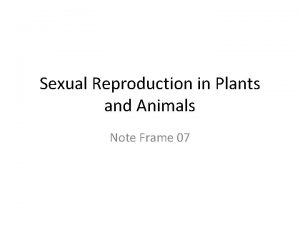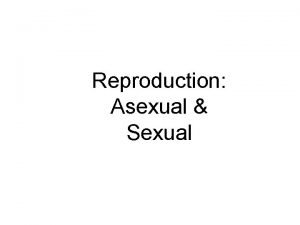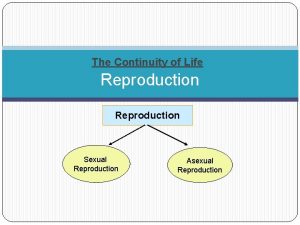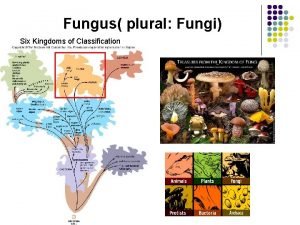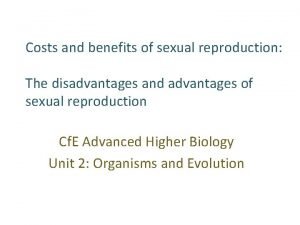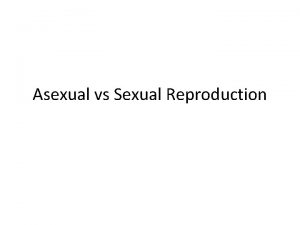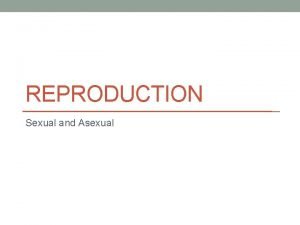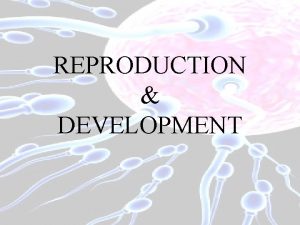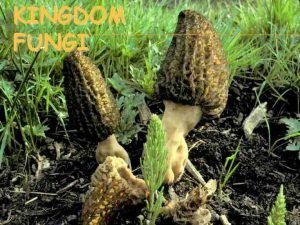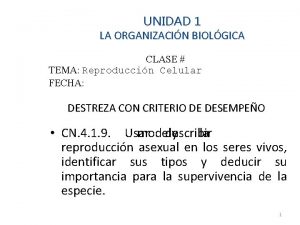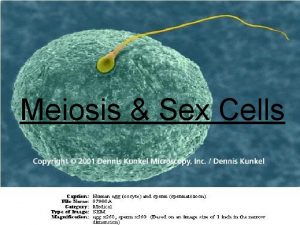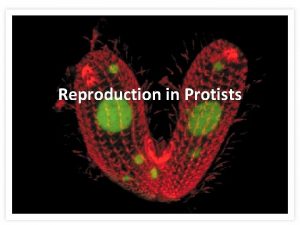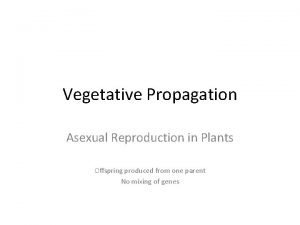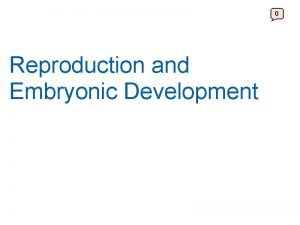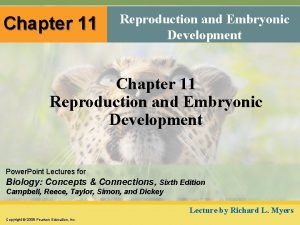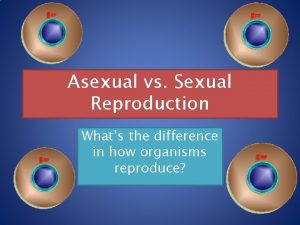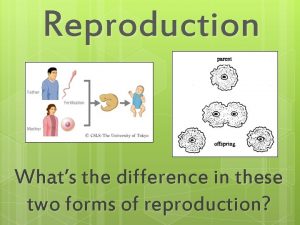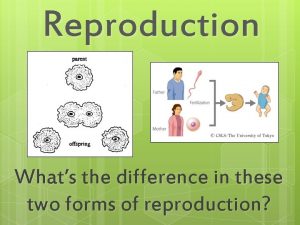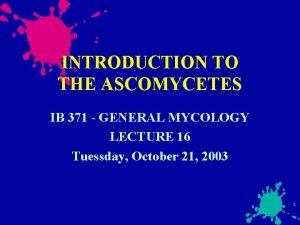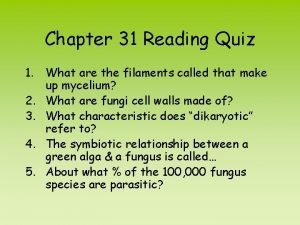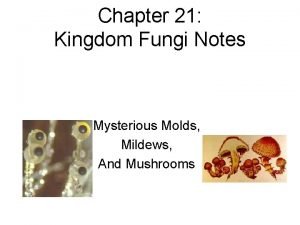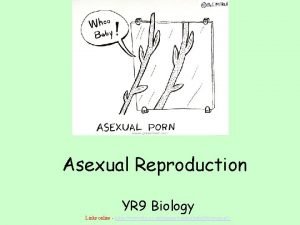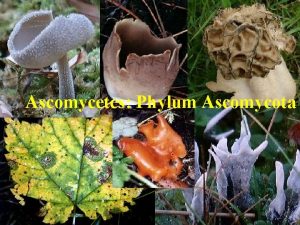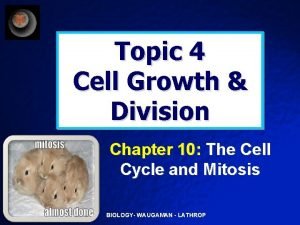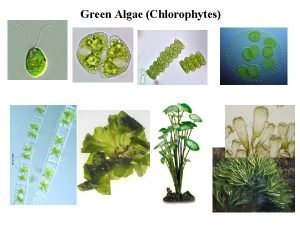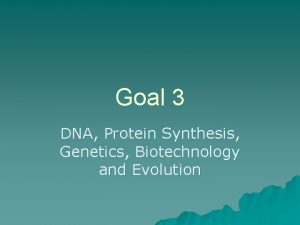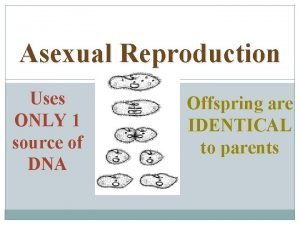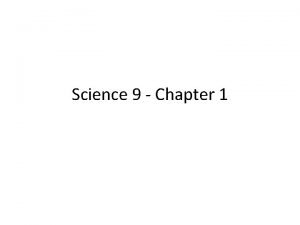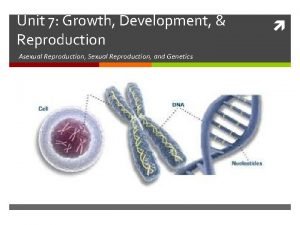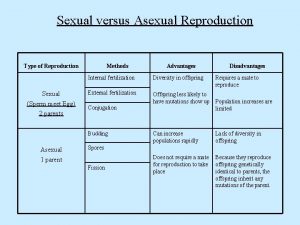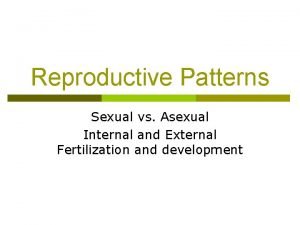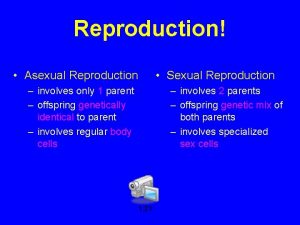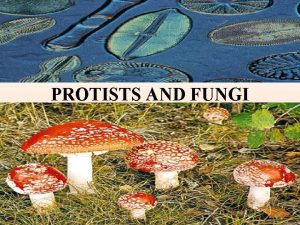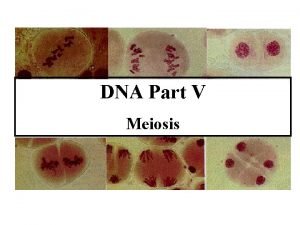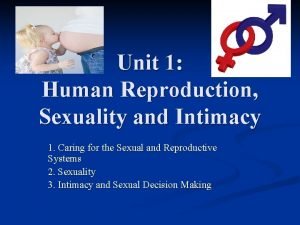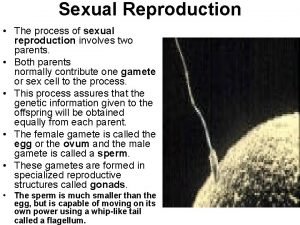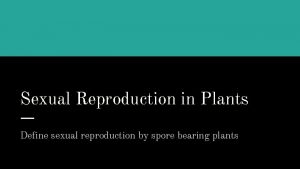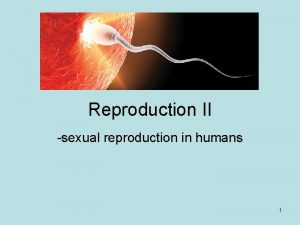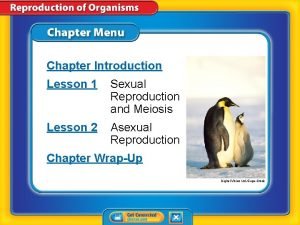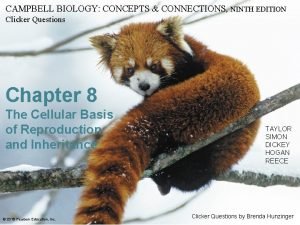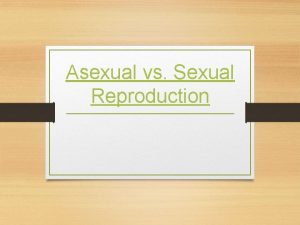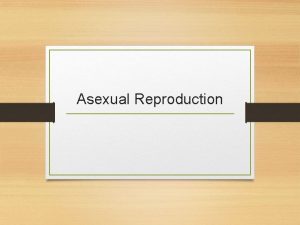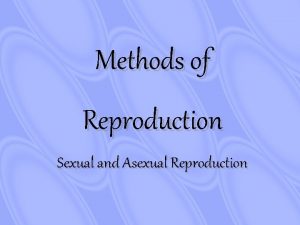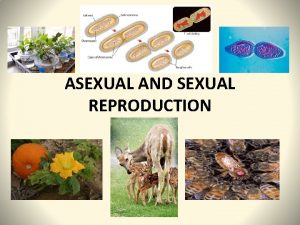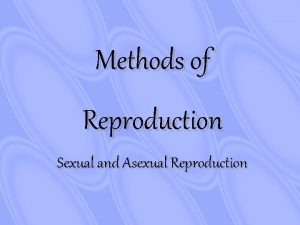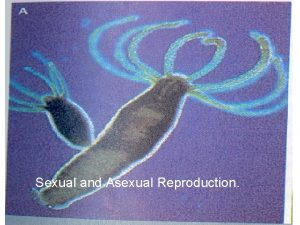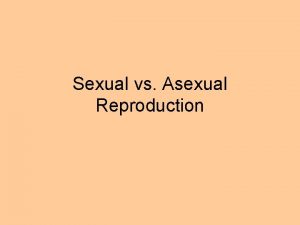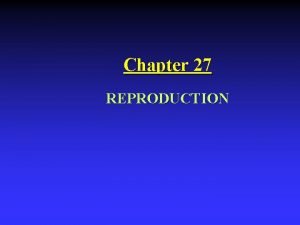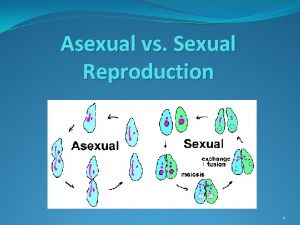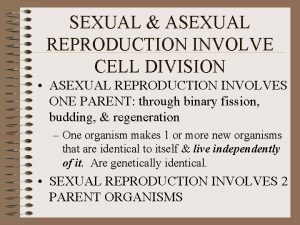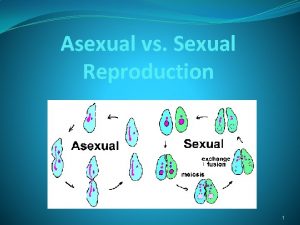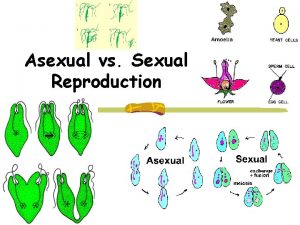Asexual and Sexual Reproduction Reproduction There are two




































































- Slides: 68

Asexual and Sexual Reproduction

Reproduction: There are two types of reproduction: Sexual Reproduction Asexual Reproduction

Asexual Reproduction The production of offspring from 1 parent, without the union of gametes. Offspring are genetically identical to parent (identical genetic makeup. ) An individual produced by asexual reproduction is a clone. A clone is an organism that is genetically identical to its parents. Only mitotic cell division occurs in asexual reproduction. Methods of Asexual Reproduction in monerans (bacteria), protests, fungi, and plants include binary fission, budding, vegetative propogation, and spore formation. The advantage for bacteria producing by binary (asexual reproduction) is that it can be done so fast. Ex: E. coli can produce “ 1 million” new cells in 7 hours!!! Asexual reproduction allows organisms to produce many offspring in a short period of time.

Binary fission in an amoeba

Binary fission in Bacteria or amoeba 1 st DNA is copied so that each new cell will have a copy of the genetic information. 2 nd The bacterium or amoeba is pinched into 2 independent cells

Budding New individuals split off from existing ones. The bud may break from the parent and become an independent organism Examples of organisms that bud: yeast, hydra, sea anemones

Vegetative Propagation: Plants send out runners that allow new plants to grow. A cutting of a leaf or stem from a plant can be rooted to form a new plant Asexual; Examples of plants: strawberries, tulips, grasses, potatoes and other “tubers” Regeneration: • Some simple animals can regrow a new body part if a piece gets broken off • Fragmentation: If enough genetic material is present then a entirely new organism can form • Examples: sponges, starfish, planaria, etc


Alternation of Generation: Some organisms, such as ferns, use both sexual and asexual reproduction.

Advantages of Asexual Reproduction Produces a large number of offspring Fast Increases chance of survival in favorable environment Requires only one parent Does not have to search for other parent Disadvantages of Asexual Reproduction: Genetically identical (clones) offspring struggle to adapt Making them more susceptible to death (what kills one, kills them all) Limited survival in a changing environment

1. Sexual Reproduction Two parents are involved, each contributing a sex cell, or gamete. The production of offspring through meiosis. Gametes (egg & sperm – haploid cells) fuse to produce a diploid zygote, which then develops into a new organism. During meiosis, members of a pair of chromosomes tend to exchange genetic material before they separate. As a result, sex cells contain different sets of chromosomes and genes. The union of a sperm cell and an egg cell will produce gene combinations that differ from those of the parents. Sexual reproduction allows the recombination of genetic information.

Advantages of Sexual Reproduction: Genetically different offspring This helps organisms adapt and survive in changing environments Disadvantages of Sexual Reproduction Produces small number of offspring Slow Requires two parents

Conjugation: type of sexual reproduction where 2 parent organisms exchange genetic material. One bacteria swaps genetic information with another using a plasmid (circular DNA) No offspring are produced but new combinations of genes are formed that can be passed to future offspring Examples of organisms: mostly bacteria, some unicellular eukaryotes like protozoa and fungi

Bacterial Conjugation

State Test Quesiton Compared to sexual reproduction, asexual reproduction results in a— greater variation in offspring. larger number of identical cells. longer life span of a cell. fewer number o cells dividing

State Test Question Meiosis results in greater genetic variation than asexual reproduction because it— is a lengthy process full of errors. results in a greater number of offspring. is more common in higher order species. allows the recombination of genetic information.

State Test Question What are two sources of genetic variation associated with sexual reproduction? Binary fission and budding Mitosis and meiosis Crossing over and independent assortment Diploid gametes and DNA replication

State Test Question Bacteria cells reproduce by binary fission, a type of asexual cell division. One advantage of binary fission is— greater genetic variation in daughter cells. the ability to reproduce quickly. greater resistance to disease. the ability to live under anaerobic conditions.

State Test Question The primary difference between sexual and asexual reproduction is— asexual reproduction occurs only in multicellular organisms. asexual reproduction requires a multicellualr parent and a single-celled parent. sexual reproduction combines DNA from parent cells. sexual reproduction occurs in only singlecelled organisms.

State Test Question According to the graph, one reason that more of the Animal A population survived is because sexual reproduction produces— individual variation within a population. larger numbers of viable offspring. more female individuals than male. different forms for each generation.

I. Meiosis is a special type of cell division that produces haploid cells. It only occurs in the gametes (sex) forming cells of the male and female organism. When the gametes unite at fertilization, the original chromosome number for that organism is restored in the new individual. The formation of gametes is essential to the continuation of a species. This special process of gamete formation from diploid cells is called meiosis. The cells produced in this process have half (haploid) the number of chromosomes than the original cells. There are 2 divisions in this process.

State Test Question In order for humans to have a normal number of chromosomes, sex cells must be— haploid. diploid. triploid. tetraploid.

State Test Question What is the primary purpose of meiosis? Production of haploid somatic cells Production of diploid gametes Production of proteins Production of haploid gametes

State Test Question Unlike mitosis, meiosis occurs only in— reproductive cells. muscle cells. connective tissue cells. nerve cells.

State Test Question What structures carry the MOST genetic information for a leaf cell? Chromosomes Ribosomes Centrioles Chloroplasts

• Male and female meiosis processes are different in the number of cells produced. Crossing over and swapping of genetic information can occur during Prophase I of this process.

Somatic Cell- Any “body” cell other than a sperm or egg cell. Autosome- A chromosome found in a cell that is NOT a sex determining chromosome. Sex Chromosome- A chromosome that determines the organism’s sex—male or female. XX= female and XY= male. Ova/Egg- The sex cell formed in the female by meiosis. Sperm- The sex cell formed in the male by meiosis. Fertilization- Union of egg and sperm to form a new individual organism. Zygote- A fertilized cell. A diploid cell that results from the union of egg and sperm. Sex Chromosomes Somatic Cell (Liver Cell) Zygote Egg, Sperm, Fertilization

Meiosis is known as the cell division in which 1 diploid (2 n) cell produces 4 haploid (n) cells called sex cells or gametes, which have half the number of chromosomes as a body cell of the parent cell. K. During meiosis, the chromosome number is REDUCED by one half and gametes are formed. Meiosis occurs in the _REPRODUCTIVE_organs, the _OVARIES_in females, and the _TESTES_in males. E. The gametes are ova, or _EGG_, in females, and _SPERM_in males. F. The union of the egg and the sperm is called _FERTILIZATION_and produces a zygote. L. A sex cell begins meiosis with the diploid number (2 n=46) of chromosomes in humans.

The cell undergoes two divisions, but the chromosomes are duplicated only once. The two divisions result in 4 daughter cells, each having one half the number of chromosomes of the parent cell (haploid number or n=23 chromosomes in humans. ) Egg (23) + Sperm (23) → Zygote (46) Unlike body/somatic cells which contain 46 chromosomes (2 n), the sex cells each contain 23 (n) chromosomes, so when fertilization occurs, the zygote will have 46 chromosomes. **If a gamete contained the 2 n number of chromosomes, fertilization would result in a zygote with twice the diploid number, or 92 chromosomes and not viable (not being able to survive). Humans have 23 pairs of chromosomes. One pair are the sex chromosomes.

State Test Question Sexual reproduction in plants depends on sex cells being produced by the process of— osmosis. fermentation. transpiration. meiosis.

Formation Of Egg And Sperm Oogenesis The formation of the egg cells in females occurs in the ovaries Produces 1 viable egg cell and 3 POLAR BODIES. Immature diploid egg cell divides in Meiosis I, but almost all cytoplasm and organelles go into one cell. It may or may not go through the rest of Meiosis II to produce two more polar bodies. The cell with the most cytoplasm and organelles becomes the mature ovum. The polar bodies disintegrate.

Formation of egg and sperm Spermatogenesis The formation of the sperm cell in males occurs in the testes Produces 4 viable SPERM cells All sperm are equal in size Starts with 1 immature diploid sperm cells and ends with 4 haploid spermatozoa In plants: Sexual reproduction occurs when pollen (sperm grain) fertilizes an egg cell creating a seed Pollination: transfer of pollen from the male reproductive organ to the female reproductive organ in plants.

Oogenesis Spermatogenesis

Meiosis Process In meiosis a spindle forms and cytoplasm divides in the same way as occurs in mitosis, but what happens to the chromosomes in meiosis is very different. Meiosis has two divisions: Meiosis I—Meiosis I begins with 1 diploid (2 n) cell. Meiosis II—By the end of Meiosis II, there are four haploid (n) cells.


During Interphase that precedes Meiosis I, the cell also replicates its chromosomes (DNA). Each chromosome then consists of two identical sister chromatids, held together by a centromere. So, meiosis starts with homologous chromosomes (homologous chromosomes are similar in size, shape, and genetic content. )

Meiosis I: There are four phases of Meiosis I: Prophase I Metaphase I Anaphase I Telophase I * (on the following slides) These are unique steps to meiosis. They do not occur in mitosis

1. Prophase I *Step 1—The chromosomes (DNA) coil up becoming visible and a spindle forms. The nuclear membrane and nucleolus disappear. *Step 2— Synapsis occurs Synapsis is the pairing of homologous chromosomes. A tetrad is formed. A tetrad is the pair of homologous chromosomes. **Crossing over can occur here.

C. Crossing over i. The exchange of genetic material. ii. This allows for genetic variation among organisms.

2. Metaphase I Tetrads are moved by spindle fibers to the equator. **They line up in homologous pairs. In mitosis, they line up independently.

3. Anaphase I Homologous chromosomes separate, chromosomes of sister chromatids move to opposite poles. **The chromatids do not split as in mitosis. Whole X’s

4. Telophase I Chromosomes gather at the poles of the cell. The cytoplasm divides. **Each cell has 1 homologous pair. These chromosomes are still attached by centromeres forming two daughter cells. Another cell division is needed because each chromosome is still doubled, containing two identical sister chromatids.

Between Meiosis I & II, some organisms’ cells can undergo interkinesis (cytokinesis I, interphase II) DNA does NOT copy itself, nuclear membranes may temporarily form, cytoplasm splits, cells rest, and may grow before beginning Meiosis II

Meiosis II is similar to mitosis in that the chromatids separate. There are four phases of Meiosis II: Prophase II –A new spindle forms around the chromosomes. Metaphase II-chromosomes move to the equator of the cell. Anaphase II-Sister chromatids separate and move to opposite poles. Telophase II-Spindle fibers dissolve, nuclear membrane reappears, and the cytoplasm divides.


At the end of Meiosis II, 4 haploid cells (n=23) have been formed from the original diploid cell (2 n=46) Mitotic Cell Division Meiotic Cell Division

State Test Question During which phase of the process pictured below is DNA replicated? Prophase II Metaphase II Anaphase II Telophase II and Cytokinesis II

Fertilization Egg 23 + Sperm 23 = Zygote 46 23 + 23 = 46 When a sperm fertilizes an egg, the zygote once again has the diploid number of chromosomes. It can then develop by mitosis into a multicellular organism. Zygote (1 cell) then divides by mitosis and becomes a morula Morula: a solid ball of cells

Blastocyst: morula continues growing and dividing until it becomes a hollow ball Embryo: blastocyst develops into an embryo Fetus: develops after embryo Stem cells: early cells capable of becoming any type of cell Cellular differentiation: stem cells in the blastocyst form various specialized cells Zygote, morula, blastocyst, embryo, fetus




V. Comparison of meiosis to mitosis. A. DNA replication takes place only once during both meiosis and mitosis. However, there are two nuclear divisions during meiosis and only one during mitosis. B. Four daughter cells (gametes) are produced by meiosis. Mitosis results in two daughter cells. C. The four gametes formed by meiosis are haploid. The daughter cells produced by mitosis have the same chromosomal number as the parental cell (DIPLOID). D. The four daughter cells from meiosis are not genetically identical to each other or to the mother cell. The daughter cells from mitosis are genetically identical to each other and to the mother cell.

State Test Question Human cells have 46 total chromosomes in 23 pairs. Which of the following represents the changes in chromosome number through the stages of meiosis? Which of the following is a characteristic of asexual reproduction? Offspring identical to a single parent Unique haploid gametes Unique offspring from two parents Crossing over during synapsis

State Test Question Meiosis is different from mitosis because meiosis produces— consistent genetic makeup of all gametes. larger daughter cells. two gametes for every original parent cells with half the number of chromosomes.

State Test Quesiton The number of chromosomes in the egg of a potato plant is 24. The number of chromosomes in the cells of the potato root is— 12 24 36 48

State Test Question A species with 12 chromosomes in each somatic cell will produce sex cells with— A. 3 chromosomes. B. 4 chromosomes. C. 6 chromosomes. D. 24 chromosomes

Change in Chromosome Number Karyotype Type of chromosomal analysis that photographs a person’s chromosomes from a somatic cell (46 chromosomes, 23 pairs) and arranges them in order of size and shape. • Used to check for chromosomal defects (mutations) • Helpful in diagnosing Down’s Syndrome. • Homologous chromsomes are pairs of chromsomes containing genes that code for the same trait. The number of chromosomes can be studied using a karyotype. •


Each of an individual’s 46 chromosomes has thousands of genes. Since genes play an important role in determining how a person’s body develops and functions, the presence of all 46 chromosomes is essential for normal development and function. Humans who are missing even one of the 46 chromosomes do not survive in Most cases

A karyotype is helpful in diagnosing Down’s Syndrome (trisomy 21). People with Down’s syndrome have 47 chromosomes. A karyotype can tell it there is an extra copy of chromosome 21, a missing 23 rd chromosome, more than one X chromosome. A karyotype can’t show individual genes on chromosomes. The nuclei of cells (somatic cells) are examined at the stage of mitosis when they are most visible that is, at metaphase. The chromosomes are stained and photographed under the light microscope, as shown in part A. Pairs of homologous chromsomes are then arranged according to a standard numbering system from 1 to 22 and X, Y. Karyotype analysis reveals any gross chromosomal abnormalities

Nondisjunction The failure of chromosome pairs to separate properly during cell division (anaphase) • Examples of disorders: • Down’s Syndrome (trisomy) Cat Eye Syndrome (trisomy) Cri du chat (monosomy) Turner’s Syndrome


State Test Question What is a primary difference between mitosis and meiosis? Mitosis involves two cell divisions, and meiosis involves only one. Mitosis produces diploid cells, while meiosis produces haploid cells. Interphase and DNA replication occur only in mitosis. There is no difference between the two processes.

State Test Question The purpose of meiosis is— production of haploid gametes. asexual reproduction of unicellular organisms. duplication of diploid cells. production of diploid gametes

State Test Question The final products of meiosis are— haploid cells. diploid cells. triploid cells. polypoid cells.

For Meiosis project: Prophase 1: nuclear membrane disappears, spindle fibers form, centrioles move to opposite sides of cell, chromatin becomes chromosomes then crossing over occurs Metaphase 1: No nuclear membrane, centrioles are on opposite sides of cell, spindle fibers move chromosome pairs to the center of the cell

For Meiosis project Anaphase 1: No nuclear membrane, centrioles are on opposite sides of cell, spindle fibers split chromosome pairs and move whole chromosomes to opposite sides of the cell Telophase 1: Nuclear membranes reappear, centrioles are on opposite sides of the cell, spindle fibers disappear, chromosomes become chromatin
 Sexual reproduction and asexual reproduction
Sexual reproduction and asexual reproduction The disadvantages of sexual reproduction
The disadvantages of sexual reproduction Sexual vs asexual reproduction venn diagram
Sexual vs asexual reproduction venn diagram Synapsis and crossing over
Synapsis and crossing over Asexual and sexual reproduction venn diagram
Asexual and sexual reproduction venn diagram Venn diagram sexual and asexual
Venn diagram sexual and asexual Asexual reproduction cell division
Asexual reproduction cell division Examples of sexual reproduction
Examples of sexual reproduction Asexual and sexual reproduction difference
Asexual and sexual reproduction difference Budding asexual reproduction
Budding asexual reproduction Example for asexual reproduction
Example for asexual reproduction Sexual reproduction
Sexual reproduction Sexual or asexual reproduction
Sexual or asexual reproduction Plural form of fungus
Plural form of fungus Parthenogenesis asexual reproduction
Parthenogenesis asexual reproduction Sexual or asexual reproduction
Sexual or asexual reproduction Reproduction
Reproduction Asexual or sexual reproduction
Asexual or sexual reproduction Insidan region jh
Insidan region jh Zygomycota characteristics
Zygomycota characteristics Etapas de la reproducción humana
Etapas de la reproducción humana Bacteria sexual or asexual
Bacteria sexual or asexual Reproduction of protist
Reproduction of protist Dahlia asexual reproduction
Dahlia asexual reproduction Fission vs budding
Fission vs budding Platyhelminthes asexual reproduction
Platyhelminthes asexual reproduction Layering asexual reproduction
Layering asexual reproduction Asexual
Asexual Asexual reproduction
Asexual reproduction Gastrula
Gastrula Whats sexual reproduction
Whats sexual reproduction Chapter 19 asexual reproduction answer key
Chapter 19 asexual reproduction answer key What is reproduction
What is reproduction Whats reproduction
Whats reproduction Ascomycetes life cycle
Ascomycetes life cycle Chytridiomycota
Chytridiomycota With name
With name Budding asexual reproduction
Budding asexual reproduction Runner plant examples
Runner plant examples Hymenium ascomycota
Hymenium ascomycota How do plants reproduce
How do plants reproduce Asexual reproduction of budding
Asexual reproduction of budding Phylum echinodermata
Phylum echinodermata Ulothrix
Ulothrix Asexual reproduction of budding
Asexual reproduction of budding Asexual reproduction
Asexual reproduction Asexual reproduction involves *
Asexual reproduction involves * Difference between male and female plants
Difference between male and female plants Asexual reproduction
Asexual reproduction Asexual reproduction
Asexual reproduction Sea urchin phylum
Sea urchin phylum Types of asexual reproduction
Types of asexual reproduction Involves only one parent
Involves only one parent Anal pore
Anal pore Male reproductive system plants
Male reproductive system plants Interkinesis
Interkinesis Reproduction station lab
Reproduction station lab Why is asexual reproduction beneficial
Why is asexual reproduction beneficial Sexual reproduction and genetics section 1 meiosis
Sexual reproduction and genetics section 1 meiosis Pedigree miscarriage symbol
Pedigree miscarriage symbol Sexual reproduction and genetics section 1 meiosis
Sexual reproduction and genetics section 1 meiosis Chapter 10 sexual reproduction and genetics
Chapter 10 sexual reproduction and genetics A sexual reproduction in humans
A sexual reproduction in humans Chapter 20 sexual reproduction in animals packet answers
Chapter 20 sexual reproduction in animals packet answers Sexual reproduction?
Sexual reproduction? Define sexual reproduction
Define sexual reproduction Reproduction human
Reproduction human Connecting the concepts sexual reproduction
Connecting the concepts sexual reproduction Connecting the concepts sexual reproduction
Connecting the concepts sexual reproduction








